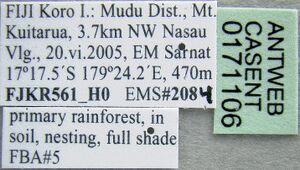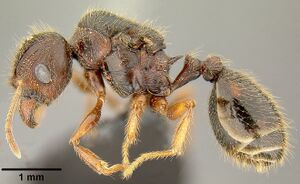Pheidole simplispinosa
| Pheidole simplispinosa | |
|---|---|

| |
| Scientific classification | |
| Kingdom: | Animalia |
| Phylum: | Arthropoda |
| Class: | Insecta |
| Order: | Hymenoptera |
| Family: | Formicidae |
| Subfamily: | Myrmicinae |
| Tribe: | Attini |
| Genus: | Pheidole |
| Species group: | roosevelti |
| Species: | P. simplispinosa |
| Binomial name | |
| Pheidole simplispinosa Sarnat, 2008 | |
Although single turret nests were observed, the species is also capable of constructing nests with multiple entrances. One such nest, from Mt. Delaikoro on Vanua Levu, was composed of irregular mounds of excavated soil. (Sarnat 2008)
Identification
Sarnat (2008) - Pheidole simplispinosa is the most distinctive of all P. roosevelti-group species. It is the only member of the group in which the spines are simple and evenly straight without becoming modified into distal angles or bifurcations. The mesonotal process so prominent in other all other P. roosevelti-group species is truncated into a blunt process such that the angle between the dorsal face of the mesonotum and the mesonotal declivity is obtuse (i.e., >90°). Beyond the simplified spine and mesonotal process, P. simplispinosa is also the smallest of this group and has the shortest limbs relative to its size. The queens of P. simplispinosa, like those of Pheidole roosevelti and Pheidole pegasus, are characterized by their well-developed mesosomas.
A significant variation in sculpture is associated with the geography of P. simplispinosa. The Koro material, including the type series, exhibits the strongest rugulae on the face and body and the most dense, well defined foveolate ground sculpture. The Taveuni specimens, with only faint hints of facial foveolae and weak mesosomal rugulae, occupy the opposing end of the phenotypic spectrum. Were it not for the intermediate Vanua Levu material, these contrasting morphologies might argue for the designation of separate species. Fortunately, enough collections of P. simplispinosa have been made on Vanua Levu to study morphological variation on the longitudinal axis. When specimens are arranged according to longitude, it becomes apparent that the strength of sculpture diminishes eastwards as the collections approach Taveuni. If sculpture strength can be used as a surrogate for relationship, it suggests that more gene flow occurs between populations from western Vanua Levu and Koro, and eastern Vanua Levu and Taveuni, than between Koro and Taveuni.
Keys including this Species
- Key to Pheidole roosevelti-group majors
- Key to Pheidole roosevelti-group minors
- Key to Pheidole roosevelti-group queens
Distribution
Sarnat (2008) - Pheidole simplispinosa has a range within the Fiji archipelago rivaled only by P. roosevelti. Like P. roosevelti, this species tolerance of lower elevation habitat, may serve as some explanation for its wide range. The two species, however, are entirely allopatric. Whereas P. roosevelti claims the more southern islands of Viti Levu and Ovalau, P. simplispinosa occurs in the northern islands of Vanua Levu, Taveuni and Koro.
Latitudinal Distribution Pattern
Latitudinal Range: -16.583° to -17.63111111°.
| North Temperate |
North Subtropical |
Tropical | South Subtropical |
South Temperate |
- Source: AntMaps
Distribution based on Regional Taxon Lists
Indo-Australian Region: Fiji (type locality).
Distribution based on AntMaps
Distribution based on AntWeb specimens
Check data from AntWeb
Countries Occupied
| Number of countries occupied by this species based on AntWiki Regional Taxon Lists. In general, fewer countries occupied indicates a narrower range, while more countries indicates a more widespread species. |

|
Estimated Abundance
| Relative abundance based on number of AntMaps records per species (this species within the purple bar). Fewer records (to the left) indicates a less abundant/encountered species while more records (to the right) indicates more abundant/encountered species. |

|
Biology
Castes
Worker
Major
Images from AntWeb
   
| |
| Not Provided. Worker (major/soldier). Specimen code casent0171106. Photographer Eli M. Sarnat, uploaded by California Academy of Sciences. | Owned by EMSC. |
Queen
Images from AntWeb
   
| |
| Not Provided. Queen (alate/dealate). Specimen code casent0171107. Photographer Eli M. Sarnat, uploaded by California Academy of Sciences. | Owned by EMSC. |
Phylogeny
| remaining Pheidole |
| |||||||||||||||||||||||||||||||||||||||||||||||||||
Relationships of roosevelti group species based on Economo et al. (2015) and Fischer et al. (2016).
Nomenclature
The following information is derived from Barry Bolton's Online Catalogue of the Ants of the World.
- simplispinosa. Pheidole simplispinosa Sarnat, 2008: 26, figs. 47-49, 68-70, 89-91 (s.w.q.) FIJI IS.
Unless otherwise noted the text for the remainder of this section is reported from the publication that includes the original description.
Description
Worker
Major. TL 5.65–6.78, HL 1.78–1.96, HW 1.64–1.84, CI 0.89–0.93, FL 1.09–1.22, FI 0.60–0.64, SL 0.73–0.84, SI 0.39–0.44 (7 measured).
Head with sides not distinctly broader posterior to eyes than anterior to eyes. Median ocellus occasionally present. Scapes short. Mesonotal process, in profile, truncated into a blunt process without lamellate posterior margin; in dorsal view posterior margin flat to convex. Propodeal spines simple, evenly tapering to a single straight acuminate point without becoming bifurcate or angulate apically. In posterior view, petiole node dorsum strongly excised, sides moderately excised. Postpetiole taller than long, as tall as petiole, steep anterior and posterior faces converging to form an obtusely angulate vertex; in dorsal view subpentagonal with strong lateral projections.
Region between frontal carinae with parallel longitudinal carinae extending posteriorly and arcing onto posterolateral corners. Posterolateral lobes, in full face view, with distinct transverse rugae extending from median cleft to posterolateral corners. Sculpture of vertex and posterolateral lobes varies from weakly to densely rugoreticulate. Intercarinular spaces vary from densely foveolate to smooth and shining. Rugoreticulum present between eye and antennal insertion. Antennal scrobe mostly smooth and shining to strongly foveolate. Clypeus smooth and shining; anterior margin without carinae. Lateral and ventrolateral portions of posterolateral lobes lightly sculptured to entirely smooth and shining; posteriorly with transverse striae, discontinuous rugae and shallow oblong impressions. Head venter rugose. Pronotal sculpture varies from dense foveolate ground sculpture overlain by transverse striae to weak foveolate ground sculpture overlain by weak transverse striae. Mesonotum, in dorsal view, varies from foveolate and striate to smooth and shining. Anepisternum weakly rugose. Katepisternum weakly striate. Petiole with apical and posterior faces smooth, laterally and ventrally rugose. Postpetiole dorsum mostly smooth and shining, sides rugose. Basigastral costulae weakly to moderate with interspaces smooth and shining to foveolate; sternite of first gaster segment lightly sculptured laterally. Gaster otherwise smooth and shining. Body reddish-brown with lighter appendages.
Minor. TL 2.96–3.41, HL 0.66–0.75, HW 0.65–0.74, CI 0.98–1.03, FL 0.80–0.91, FI 1.18–1.29, SL 0.77–0.85, SI 1.10–1.23, AE 0.25–0.32, DE 0.00, PSI 0.00 (10 measured).
Head, in full face view, subcordate, sides convex, posterolateral corners rounded and obtuse, posterior margin concave; in profile, posterolateral corners not pinched. Genal carinae very short and weakly elevated on ventrolateral portion of head. Clypeus with anterior margin convex laterally, concave medially. Frontal carinae terminating before eye level. Mesonotal process truncated into a short process without lamellate or distinct margin; in dorsal view, attachment to mesonotum broad, posterior margin evenly convex. Propodeal spines simple, taper evenly to an acuminate point without distal angle or bifurcation.
Head mostly smooth and shining to latitudinally rugulose with densely packed foveolate ground sculpture; ventrally smooth and shining. Clypeus with a few weak carinae attached to anterolateral border. Promesonotum, in dorsal view, transversely rugulose with lightly impressed to densely packed foveolate ground sculpture. Mesopleuron mostly smooth and shining to foveolate. Reddish-brown with paler appendages.
Queen
TL 6.82, HL 1.29, HW 1.37, CI 1.06, SL 0.87, SI 0.68, FL 1.18, FI 0.91, ML 0.83, MI 1.05 (1 measured).
Head subquadrate with sides approximately as broad anteriorly as posteriorly. Mesoscutum, in profile, large, greater than half the height of pronotum; in dorsal view, mostly obscuring pronotum. Scutellum, in dorsal view, with posterior portion produced as a weakly elevated subtriangular plate. Propodeal spines simple, evenly tapering to a single straight acuminate point without becoming bifurcate or angulate apically. Petiole broadly cuneate; in posterior view, petiole node dorsum weakly concave. Postpetiole, in dorsal view, subpentagonal with moderate lateral projections.
Region between frontal carinae with crenulated longitudinal and occasionally branching carinae reach posterior margin. Region between eyes and antennal insertions with elevated crenulated carinae that reach posterolateral corners; intercarinular spaces densely packed with overlapping foveolae. Head venter rugo-reticulate. Antennal scrobe foveolate. Clypeus mostly smooth and shining; anterior margin with short carinae laterally, median carinae present. Pronotum rugo-reticulate. Mesoscutum, in dorsal view, with straight parallel carinae that run posteriorly towards median. Scutellum mostly smooth and shining. Anepisternum finely rugo-reticulate. Katepisternum weakly striate. Petiole rugose. Postpetiole rugulose. First tergite of gaster longitudinally sculptured basally, sculpture immediately posterior to postpetiole longer than length of postpetiole. First sternite of gaster sculptured basally. Reddish-brown with lighter appendages.
Type Material
Holotype major, FIJI: Koro I., Mt. Kuitarua 3.7 km NW Nasau Village, 20.vi.2005, 470m, -17.29083°, 179.40183°, primary rainforest, nesting in soil, (E. M. Sarnat), EMS#2084, CASENT0171106 (Fiji National Insect Collection, Suva).
Paratypes. From same nest series as holotype: 1 dealate queen (CASENT0171107), 4 majors (CASENT0174208, CASENT0174209, CASENT0174211, CASENT0174212), 3 minors (CASENT0171022, CASENT0174210, CASENT0174213), (FNIC, National Museum of Natural History, Australian National Insect Collection); additional specimens in alcohol (NMNH).
Etymology
The specific epithet simplispinosa is a noun in apposition derived from the combination of the Latin simplex, meaning simple, and spina, meaning spine.
References
References based on Global Ant Biodiversity Informatics
- CSIRO Collection
- Sarnat E. 2008. A taxonomic revision of the Pheidole roosevelti-group (Hymenoptera: Formicidae) in Fiji. Zootaxa 1767: 1-36.
- Sarnat Eli M. 2009. The Ants [Hymenoptera: Formicdiae] of Fiji: Systematics, Biogeography and Conservation of an Island Arc Fauna. 80-252

